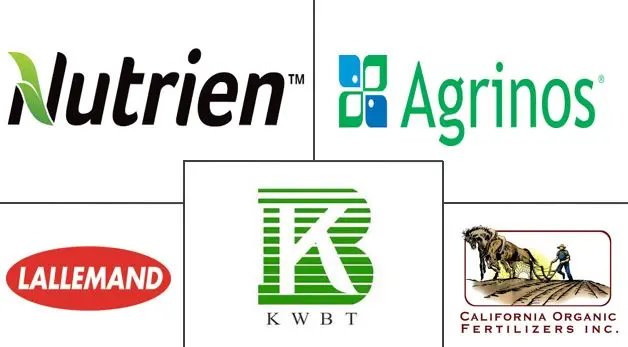Market Size of North America Biofertilizers Industry

| Study Period | 2019 - 2029 |
| Base Year For Estimation | 2023 |
| Market Size (2024) | USD 1.18 Billion |
| Market Size (2029) | USD 1.92 Billion |
| CAGR (2024 - 2029) | 10.10 % |
| Market Concentration | High |
Major Players
*Disclaimer: Major Players sorted in no particular order |
North America Biofertilizers Market Analysis
The North America Biofertilizers Market size is estimated at USD 1.18 billion in 2024, and is expected to reach USD 1.92 billion by 2029, growing at a CAGR of 10.10% during the forecast period (2024-2029).
The United States is the largest and fastest-growing market, followed by Canada. Favorable government policies, an easy registration process, and the increasing number of organic farms are the main factors driving the market. Among biofertilizers, Rhizobium biofertilizers led the market in 2019 in North America. Popular genera used as biofertilizers in North America are Bradyrhizobium, Sinorhizobium, Azorhizobium, Mesorhizobium, and Allorhizobium. In 2019, grains and cereals contributed a major share of the North American biofertilizer market among the various types of crops. Wheat, corn, and soybean are some of the major cereals grown in North America that account for the majority of the biofertilizer applications in the region.
North America Biofertilizers Industry Segmentation
Biofertilizers used in agriculture are considered under the scope of the study. Biofertilizers are defined as substances comprising living microbes, which, when applied to seed, plant, and soil, stimulate growth by the supply of essential nutrients, such as N, P, and other mineral nutrients. The report provides an in-depth analysis of various parameters of the North American biofertilizer market and includes a detailed overview of the various geographical locations across North America, along with the competitive landscape of the major market players.
The North American biofertilizers market is segmented by microorganism (rhizobium, azotobacter, azospirillum, phosphate solubilizing bacteria, mycorrhiza, and other biofertilizers), crop type (cash crops, horticultural crops, and row crops), and geography (United States, Canada, Mexico, and Rest of North America).
| Microorganism | |
| Rhizobium | |
| Azotobacter | |
| Azospirillum | |
| Phosphate Solubilizing Bacteria | |
| Mycorrhiza | |
| Other Biofertilizers |
| Crop Type | |
| Cash Crops | |
| Horticultural Crops | |
| Row Crops |
| Geography | |
| United States | |
| Canada | |
| Mexico | |
| Rest of North America |
North America Biofertilizers Market Size Summary
The North American biofertilizer market is experiencing significant growth, driven by factors such as supportive government policies, an increasing number of organic farms, and the need to enhance soil quality and crop yield in response to declining arable land. The United States leads the market, followed by Canada, with Rhizobium biofertilizers being particularly prominent. These biofertilizers are crucial for improving the bioavailability of nutrients, thereby boosting productivity and profitability in agriculture. The demand for organic food, which has been on the rise, further propels the use of biofertilizers as they align with the principles of organic farming by enhancing soil health and crop quality.
The market is characterized by a diverse range of biofertilizer products and genera, including Bradyrhizobium, Sinorhizobium, Azorhizobium, Mesorhizobium, and Allorhizobium, with Rhizobium-based products holding a significant share. The industry is highly fragmented, with major players like Kiwa Bio-Tech, Lallemand, and Nutrien (Actagro LLC) actively expanding their presence through distribution agreements. Ongoing research aims to develop stress-tolerant strains, enhancing the effectiveness of biofertilizers under various environmental conditions. Innovations such as the LALFIX® START SPHERICAL Granule, which combines plant growth-promoting microbes with rhizobium strains, exemplify the industry's commitment to advancing biofertilizer technology.
North America Biofertilizers Market Size - Table of Contents
-
1. MARKET DYNAMICS
-
1.1 Market Overview
-
1.2 Market Drivers
-
1.3 Market Restraints
-
1.4 Porters Five Force's Analysis
-
1.4.1 Threat of New Entrants
-
1.4.2 Bargaining Power of Buyers/Consumers
-
1.4.3 Bargaining Power of Suppliers
-
1.4.4 Threat of Substitute Products
-
1.4.5 Intensity of Competitive Rivalry
-
-
-
2. MARKET SEGMENTATION
-
2.1 Microorganism
-
2.1.1 Rhizobium
-
2.1.2 Azotobacter
-
2.1.3 Azospirillum
-
2.1.4 Phosphate Solubilizing Bacteria
-
2.1.5 Mycorrhiza
-
2.1.6 Other Biofertilizers
-
-
2.2 Crop Type
-
2.2.1 Cash Crops
-
2.2.2 Horticultural Crops
-
2.2.3 Row Crops
-
-
2.3 Geography
-
2.3.1 United States
-
2.3.2 Canada
-
2.3.3 Mexico
-
2.3.4 Rest of North America
-
-
North America Biofertilizers Market Size FAQs
How big is the North America Biofertilizers Market?
The North America Biofertilizers Market size is expected to reach USD 1.18 billion in 2024 and grow at a CAGR of 10.10% to reach USD 1.92 billion by 2029.
What is the current North America Biofertilizers Market size?
In 2024, the North America Biofertilizers Market size is expected to reach USD 1.18 billion.

